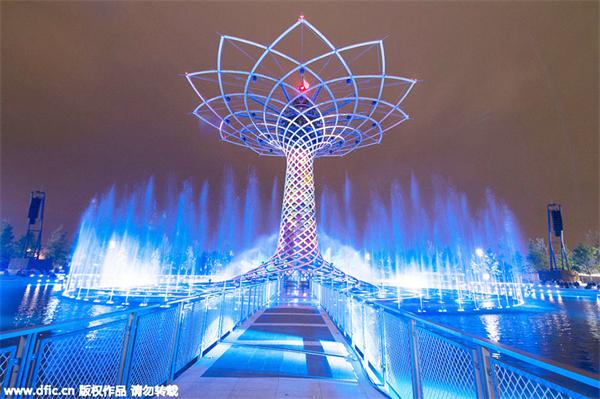 |
|
The "Tree of Life" is lit up in the night at Expo 2015 in Milan. Photo taken on May 3. [Photo/IC] |
Shanghai 2010 World Expo was a huge success. Now, Milan hosts a World Expo which is dazzling, not least because of its theme of how to feed 9 billion people of our planet by 2050.
Full of innovative ideas, high-tech animations, lively interactive programs and delicious foods, the pavilions of Germany, the United Kingdom, Italy, the Republic of Korea, Japan and China are arguably the main attractions at the 2015 World Expo.
The two days I spent at the expo last week were enlightening. But they were painful too, for I got to talk with the managers of Nepal and Haiti pavilions. The two countries have been hit by devastating earthquakes - Nepal in April this year and Haiti in January 2010.
Walking through the expo, I was astonished by a flag flowing at half-mast, only to realize that the country rocked by a killer quake that claimed about 9,000 lives was in no mood to partake the joys of the expo. And though unfinished, the pavilion of Nepal showcased the country's rich architecture. Seeing a donation box just a few steps from flag pole with two Nepalese with weary faces sitting near it, I could not help sharing their feelings.
Nearly seven years ago, one of the most deadly earthquakes shattered my home province of Sichuan. So I could relate to the sorrow of the Nepalese. Middle-aged Rabi Shrestha, one of the three men running his country's pavilion, said 12 of his colleagues returned to their country to help with the rescue and reconstruction work after the quake. But Shrestha didn't forget to thank the visitors who helped the quake victims in his country with their donations.
After talking with Shrestha, I resumed my tour of the pavilions, and while walking along the main lane of the expo, I saw an even bigger glass box for donations. This donation box, which drew many visitors, has been set up by the organizers - indeed a thoughtful gesture by the host nation.
About a kilometer from the Nepal pavilion stands the Haiti pavilion. The Caribbean country's pavilion is no bigger that a normal classroom, displaying agricultural products and handicrafts. The two managers of the pavilion shook their heads when asked about the progress of reconstruction. They said work on even the presidential building is not complete because of lack of coordination. With more than 6,000 international organizations working for Haiti's reconstruction, billions of dollars had been promised as donations but a large part of that is still to materialize.
The two Haiti managers admired China for its reconstruction work in post-quake Sichuan, wishing Haiti too had the good fortune of witnessing such leadership.
After visiting the Nepal and Haiti pavilions and that of Cuba and Sudan, I realized that the 2015 Milan Expo is also showcasing the stark disparities that plague our world.
The UN has decided to focus on global efforts for development after 2015. Post-disaster rehabilitation and reconstruction should be the main focus of the campaign, especially because lack of coordination can condemn many families into perpetual poverty.
The sharp contrast in rehabilitation and reconstruction work in Nepal, Japan, Haiti and China, all of which have been hit by strong quakes since 2008, should remind the international community that donations alone are not enough to help improve the lives of quake victims.
It should also serve as a wake-up call to the international community to take steps to ensure that the reconstruction plan in Nepal does not go the Haiti way.
The author is China Daily chief correspondent in Brussels. fujing@chinadaily.com.cn

I’ve lived in China for quite a considerable time including my graduate school years, travelled and worked in a few cities and still choose my destination taking into consideration the density of smog or PM2.5 particulate matter in the region.